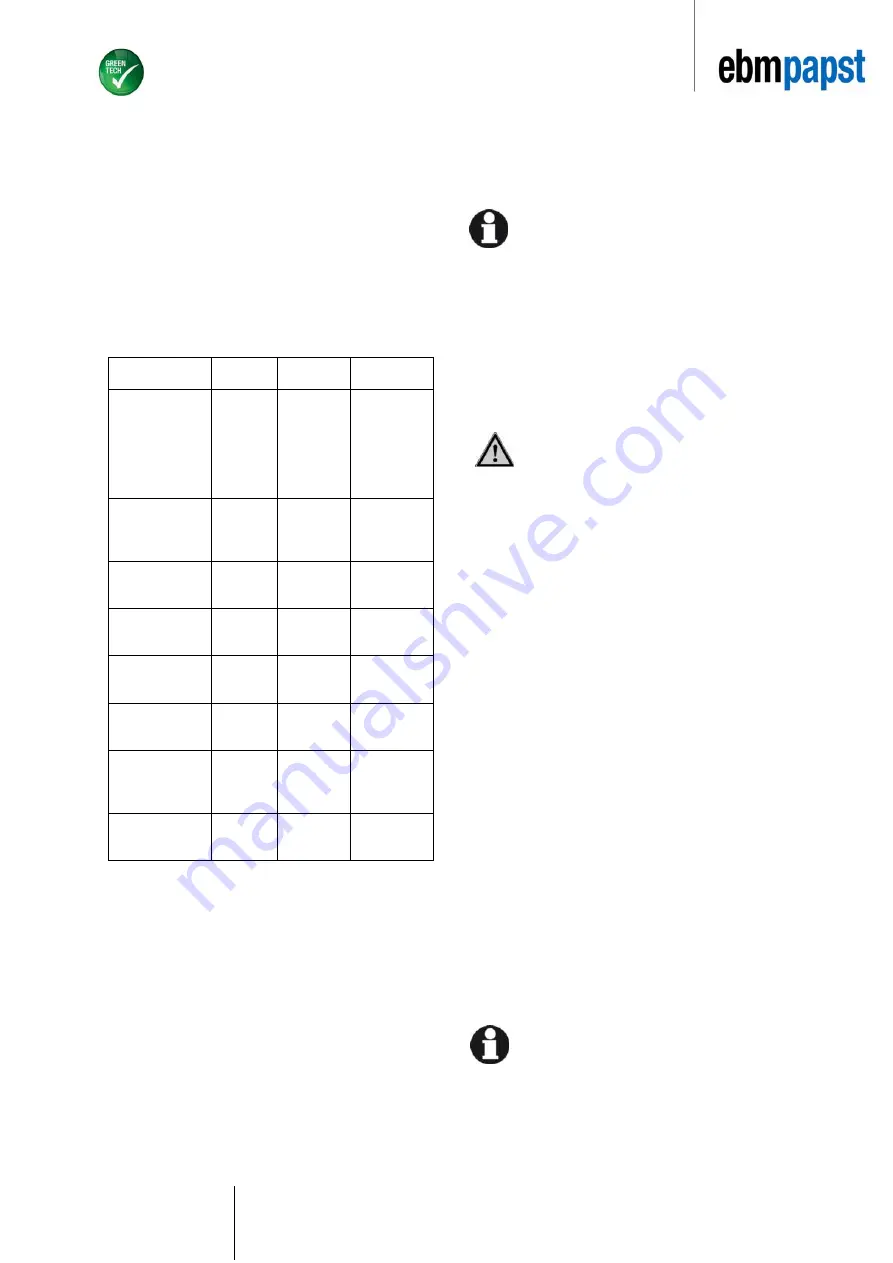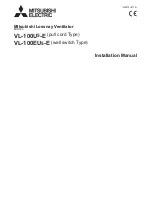
Part Number
Operating Instructions
Item no. LS-105.
Revision 003
Release 30/06/2017
Page 12 of 12
ebm-papst A&NZ Pty Ltd
10 Oxford Road · Laverton North VIC 3026 · Phone +61 (03) 9360 6400 · Fax +61 (03) 9360 6464
ABN 33 115 927 556
NSW Phone +61 (02) 9827 6400 · NSW Fax +61 (02) 9827 6464 · NZ Phone +64 (09) 525 0245 · NZ Fax +64 (09) 525 0246
sales@ebmpapst.com.au · www.ebmpapst.com.au
W3G500GN3307-LA1
6.2
Safety inspection
NOTE
High-voltage test
The integrated EMC filter contains Y capacitors.
Therefore, the trigger current is exceeded when AC
testing voltage is applied.
→ Test the device with DC voltage when you carry
out the high-voltage test required by law. The
voltage to be used corresponds to the peak value
of the AC voltage required by the standard.
What to check?
How to
check?
Frequency What
action?
The protective
casing against
accidental
contact for
damage and to
ensure that it is
intact
Visual
inspection
At least
every 6
months
Repair or
replacement
of the device
Device for
damage to
blades and
housing
Visual
inspection
At least
every 6
months
Replacement
of the device
Fastening the
cables
Visual
inspection
At least
every 6
months
Fasten
Fastening the
protective earth
connection
Visual
inspection
At least
every 6
months
Fasten
Insulation of the
cables for
damage
Visual
inspection
At least
every 6
months
Replace
cables
Tightness of
cable gland
Visual
inspection
At least
every 6
months
Retighten
replace if
damaged
Condensate
drainage holes
for clogging, as
necessary
Visual
inspection
At least
every 6
months
Open holes
Weld seams for
crack formation
Visual
inspection
At least
every 6
months
Replace
device
6.3
Disposal
For ebm-papst, environmental protection and resource
preservation are top priority corporate goals,
Ebm-papst operates an environmental management system
which is certified in accordance with ISO 14001 and rigorously
implemented around the world on the basis of German
standards.
Right from the development stage, ecological design, technical
safety and health protection are fixed criteria.
The following section contains recommendations for ecological
disposal of the product and its components.
6.3.1
Country-specific legal requirements
NOTE
Country-specific legal requirements
Always observe the applicable country-specific legal
regulations with regard to the disposal of products or
waste occurring in the various phases of the life
cycle. The corresponding disposal standards are also
to be heeded.
6.3.2
Disassembly
Disassembly of the product must be performed or supervised by
qualified personnel with the appropriate technical knowledge.
The product is to be disassembled into suitable components for
disposal employing standard procedures for motors.
WARNING
Heavy parts of the product may drop off. Some of
the product components are heavy. These
components could drop off during disassembly.
This can result in fatal or serious injury and material
damage.
→
Secure components before unfastening to stop
them falling.
6.3.3
Component disposal
The products are mostly made of steel, copper, aluminium and
plastic.
Metallic materials are generally considered to be fully recyclable.
Separate the components for recycling into the following
categories:
Steel and iron
Aluminium
Non-ferrous metal, e.g. motor windings
Plastics, particularly with brominated flame retardants, in
accordance with marking
Insulating materials
Cables and wires
Electronic scrap, e.g. circuit boards
Only ferrite magnets and not rare earth magnets are used in
external rotor motors form ebm-papst
Ferrite magnets can be disposed of in the same way as normal
iron and steel.
Electrical insulating materials on the product, in cables and wires
are made of similar materials and are therefore to be treated in
the same manner.
The materials concerned are as follows:
Miscellaneous insulators used in the terminal box
Power cables
Cables for internal wiring
Electrolytic capacitors
Dispose of electronic components employing the proper
procedures for electronic scrap.
Please contact ebm-papst for any other questions on
disposal.






























